Charles E W Bean, Diaries, AWM38 3DRL 606/243B/1 - 1916 - 1926 - Part 3
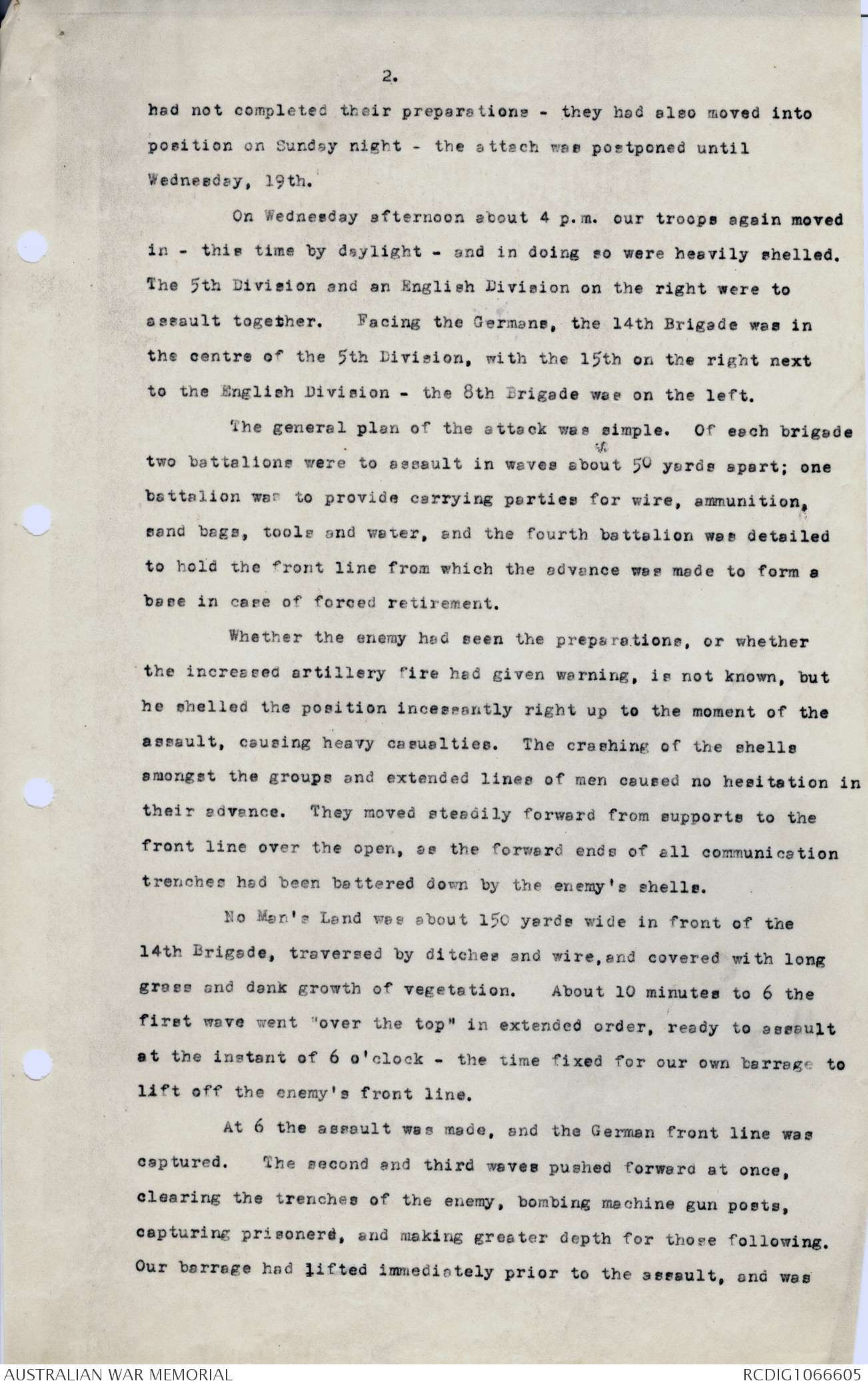
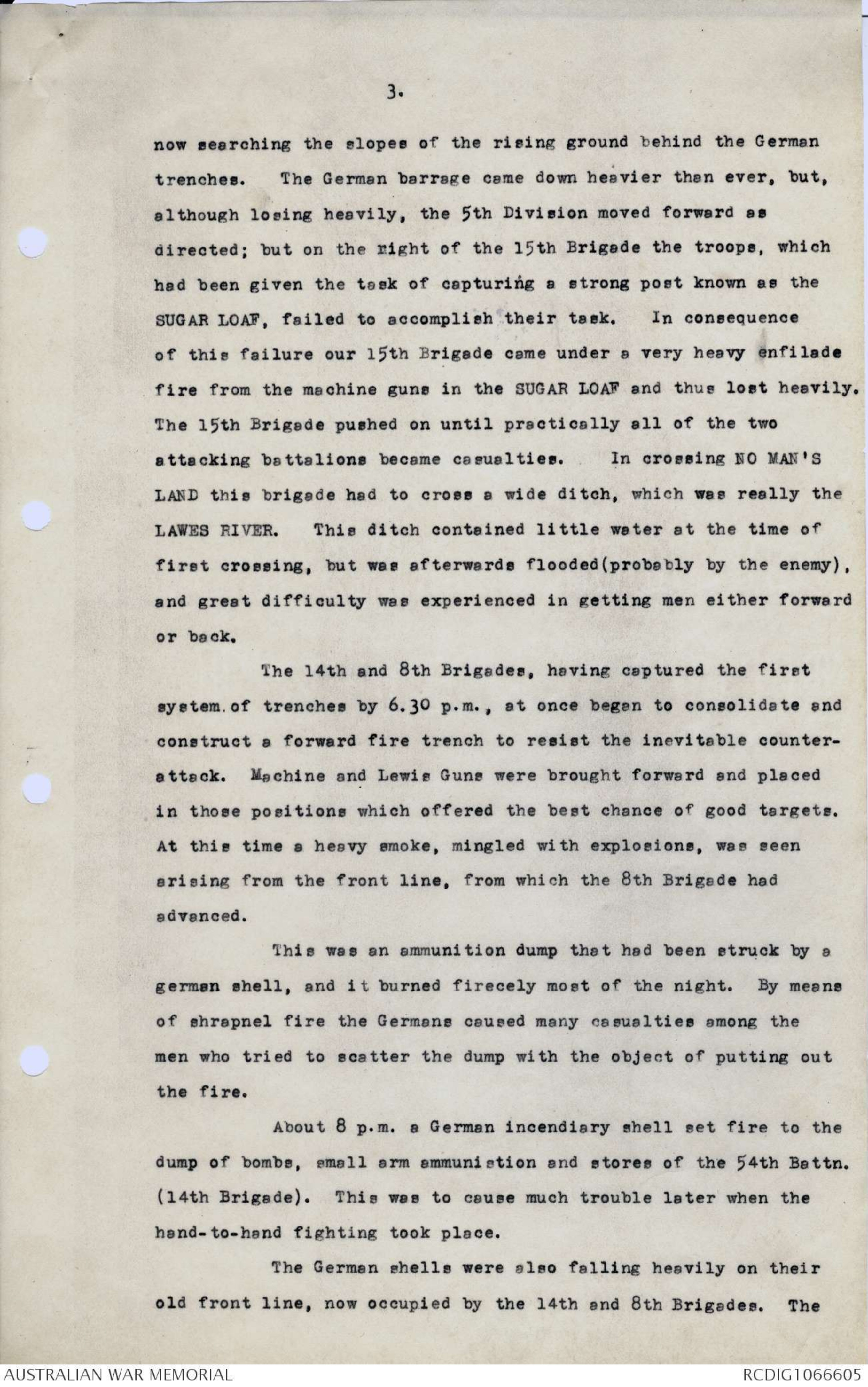
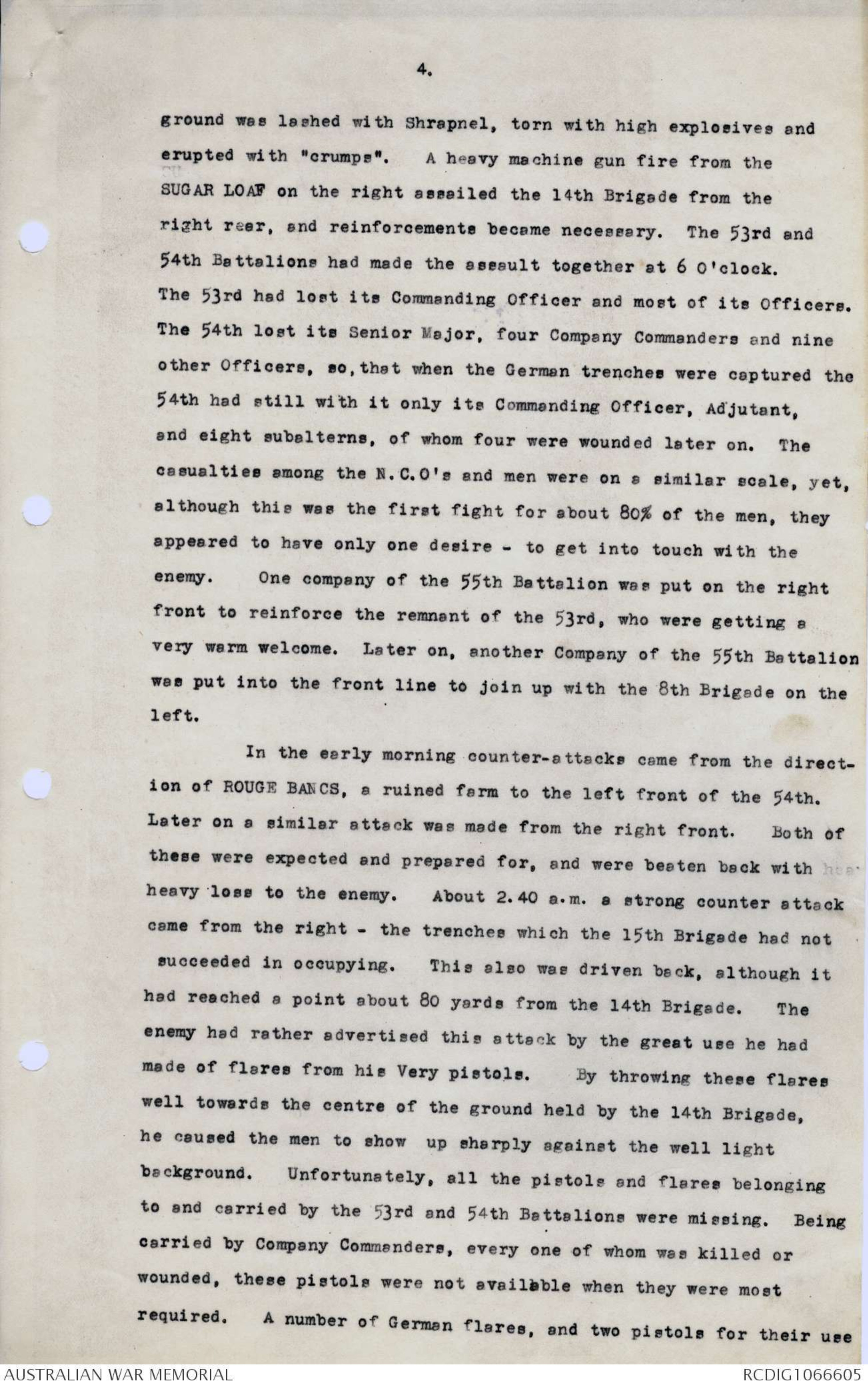
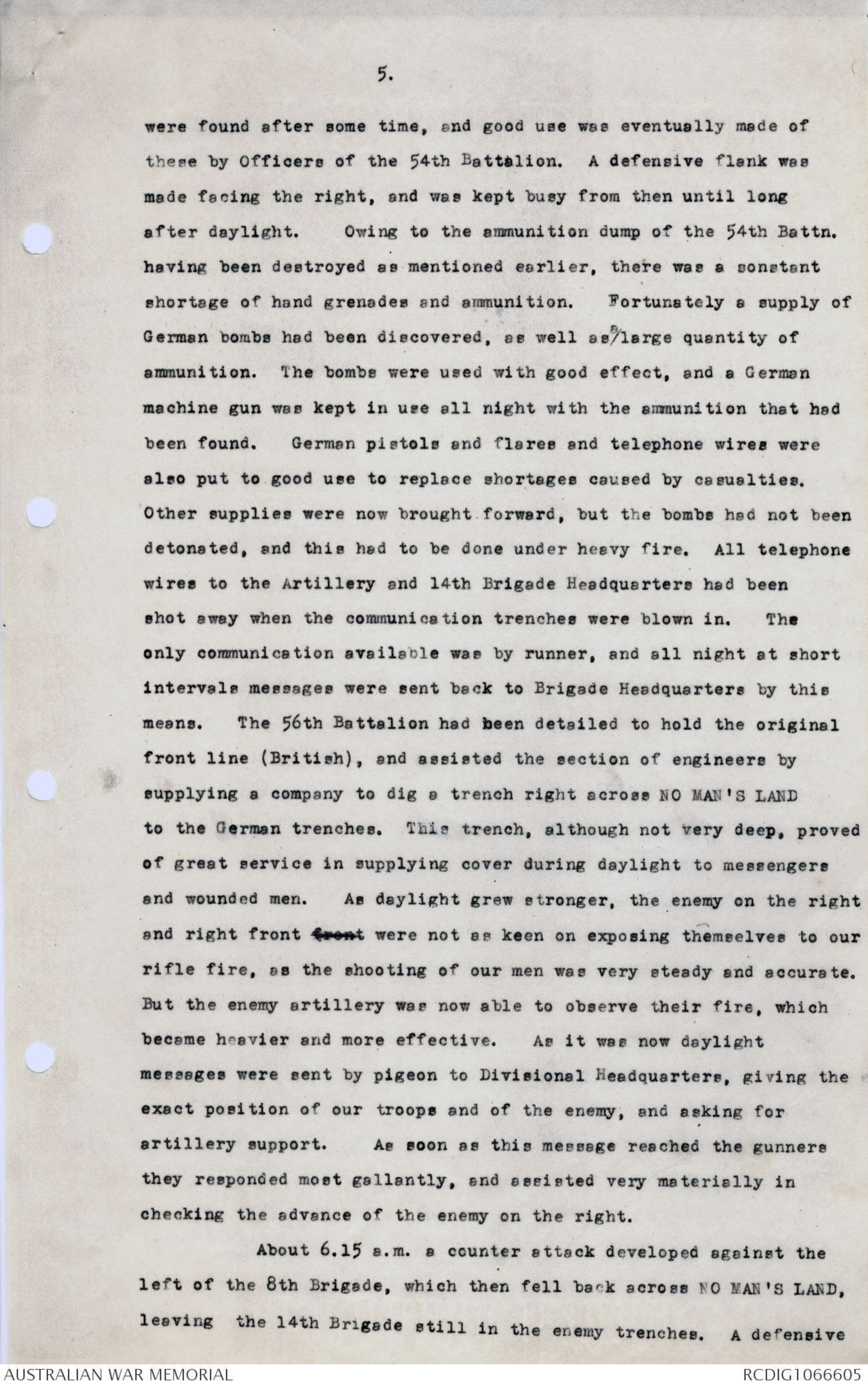
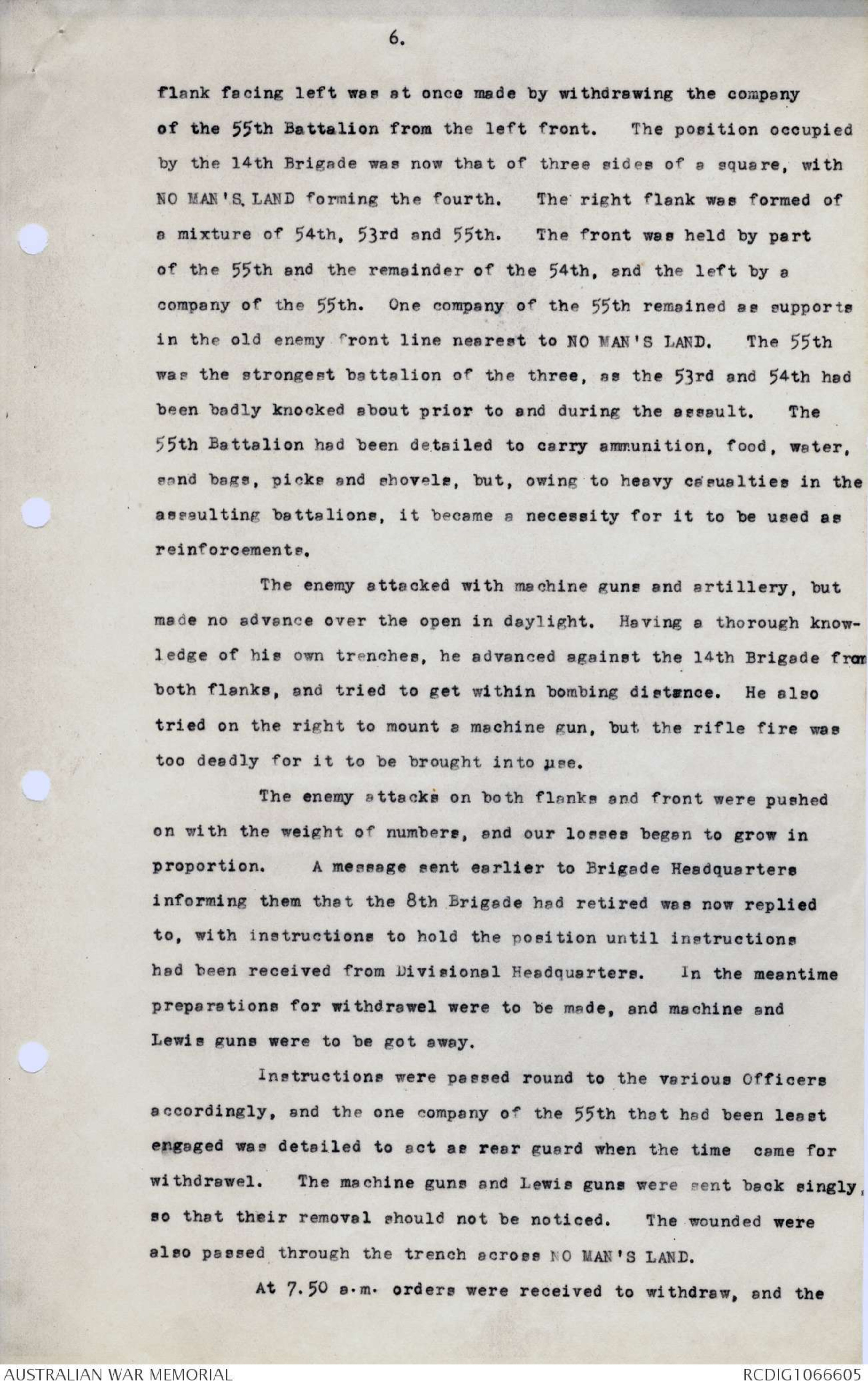
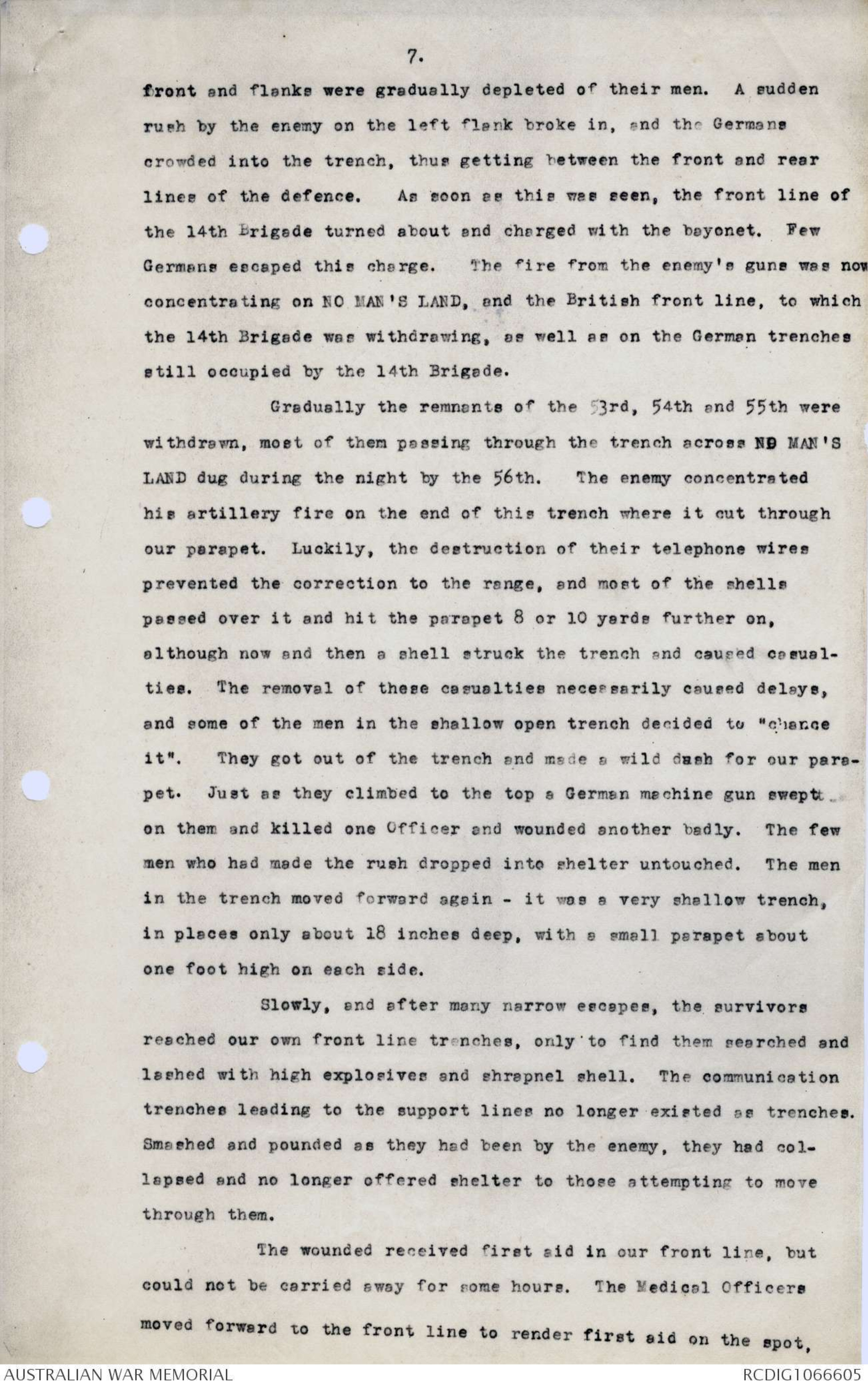
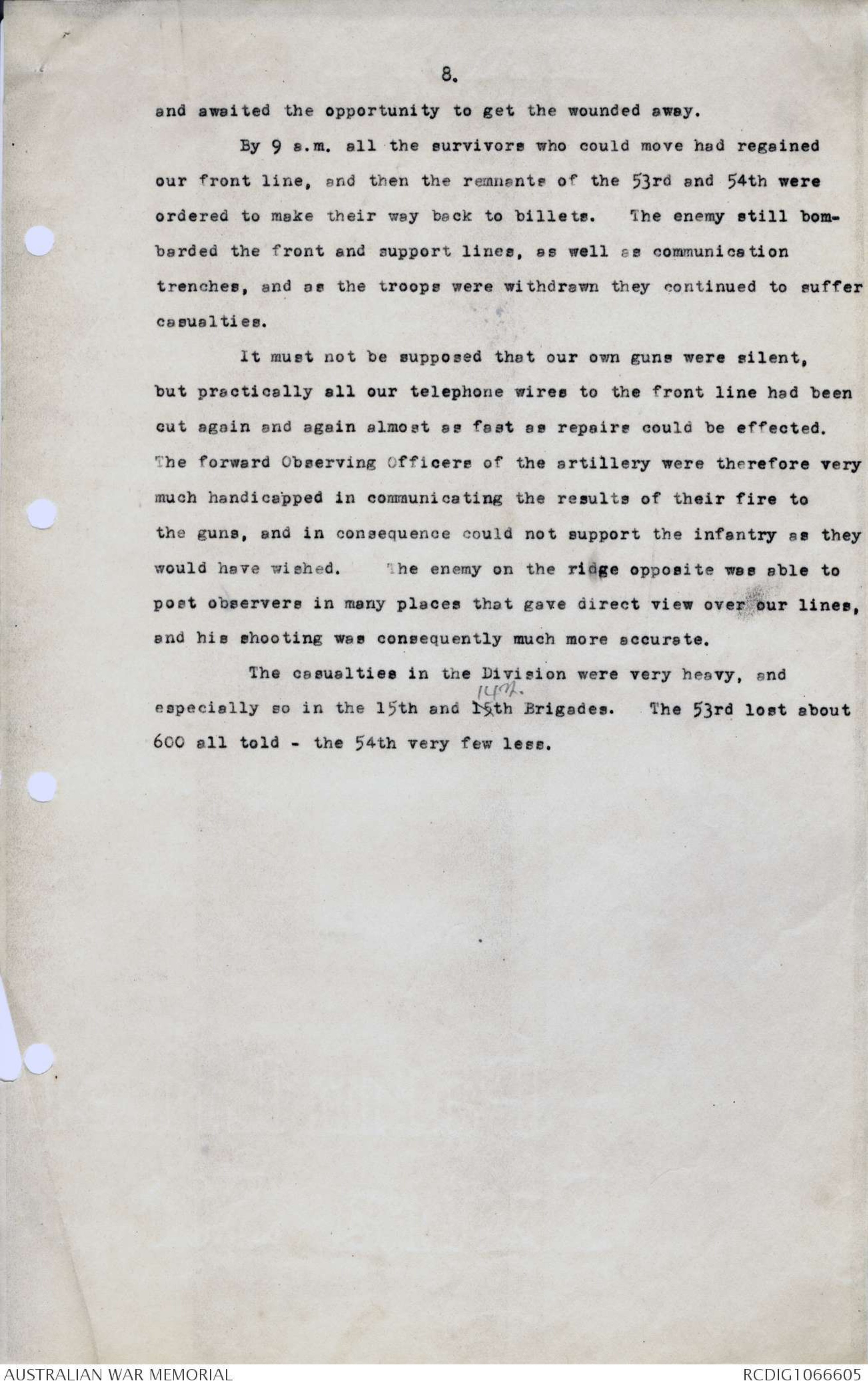
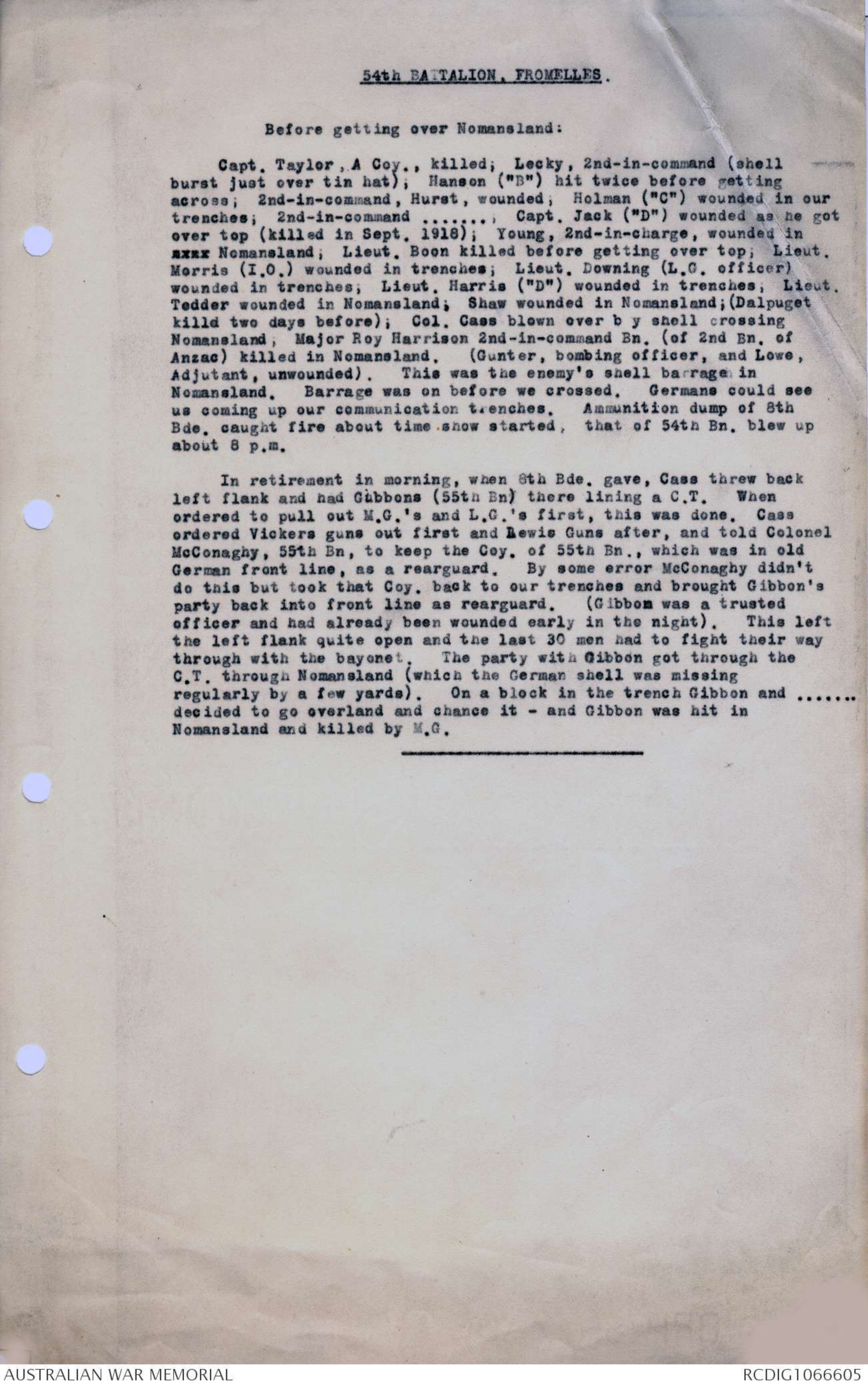
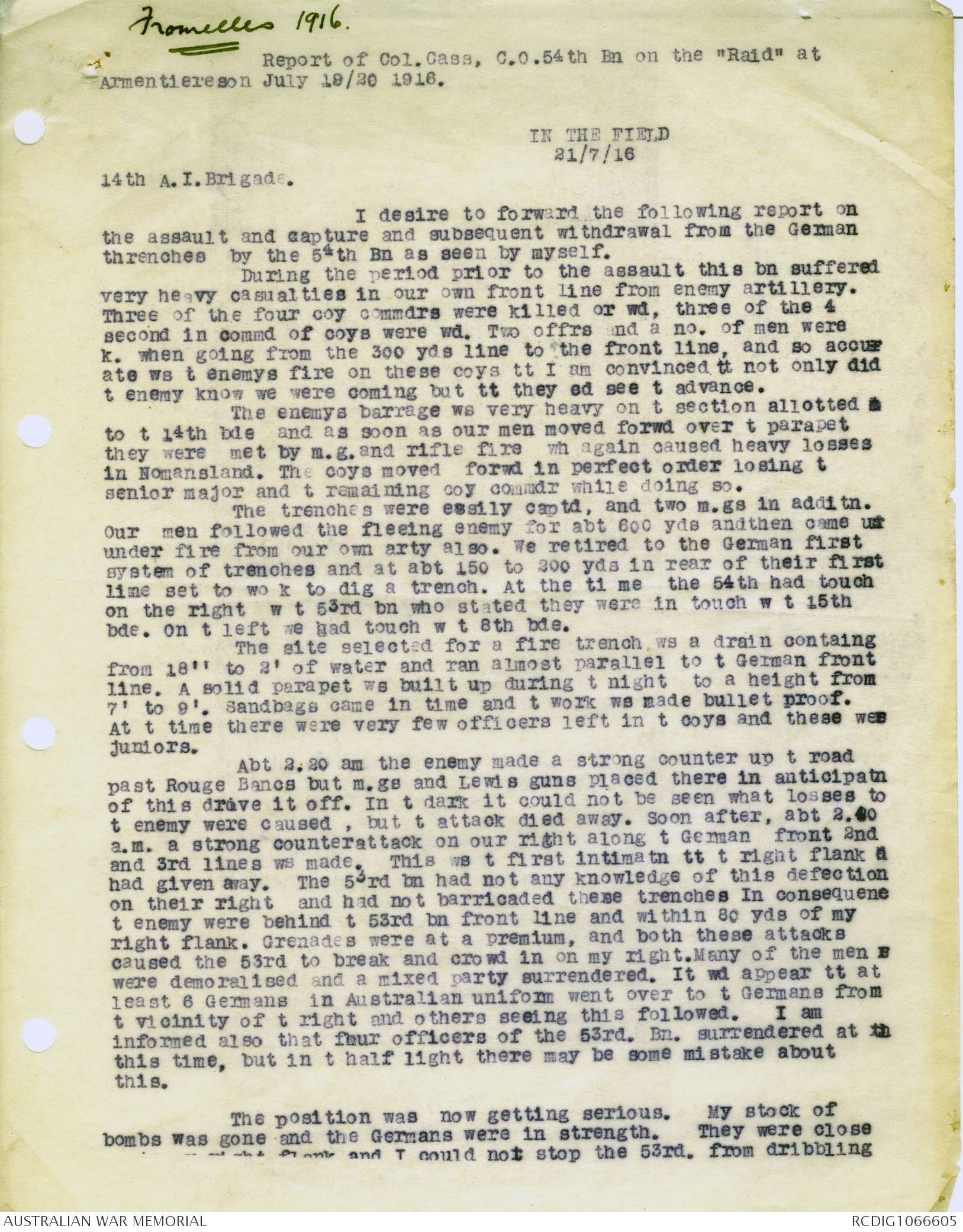
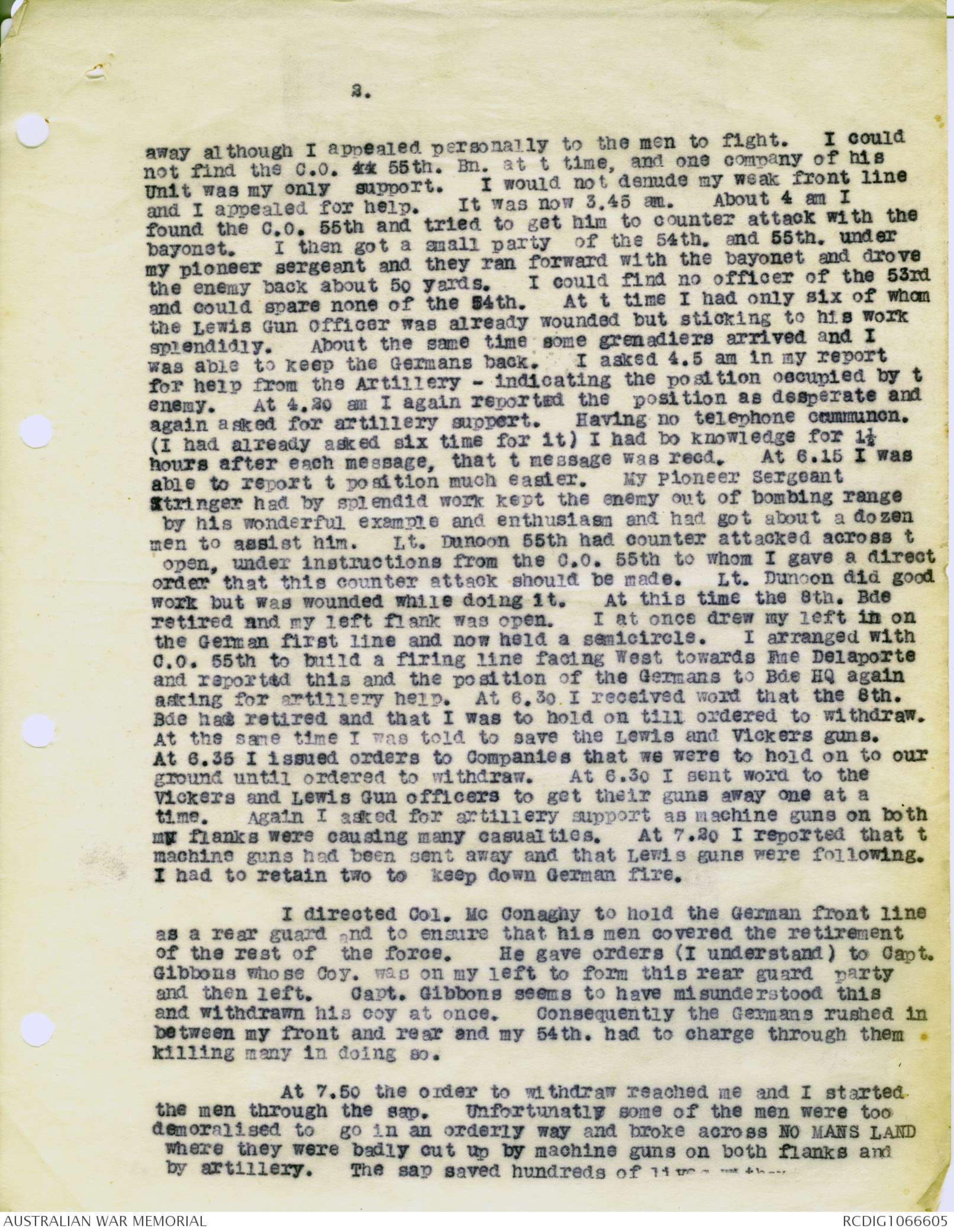
had not completed their preparations - they had also moved into
position on Sunday night - the attach was postponed until
Wednesday, 19th.
On Wednesday sfternoon about 4 p.m. our troops again moved
in - this time by daylight - and in doing so were heavily shelled.
The 5th Division and an English Division on the right were to
assault together. Facing the Germans, the 14th Brigade was in
the centre of the 5th Division, with the 15th on the right next
to the English Division - the 8th Brigade was on the left.
The general plan of the attack was simple. Of each brigade
two battalions were to assault in waves about 50 yards apart; one
battalion was to provide carrying parties for wire, ammunition,
sand bags, tools and water, and the fourth battalion was detailed
to hold the front line from which the advance was made to form a
bese in case of forced retirement.
Whether the enemy had seen the preparations, or whether
the incressed artillery fire had given warning, is not known, but
he shelled the position incessantly right up to the moment of the
assault, causing heavy casualties. The crashing of the shells
amongst the groups and extended lines of men caused no hesitation in
their advance. They moved steadily forward from supports to the
front line over the open, as the forward ends of all communication
trenches had been battered down by the enemy's shells.
No Man's Land was about 150 yards wide in front of the
14th Brigade, traversed by ditches and wire, and covered with long
grass and dank growth of vegetation. About 10 minutes to 6 the
first wave went "over the top" in extended order, ready to assault
at the instant of 6 o'clock - the time fixed for our own barrage to
lift off the enemy's front line.
At 6 the assault was made, and the German front line was
captured. The second and third waves pushed forward at once,
clearing the trenches of the enemy, bombing machine gun posts,
capturing prisoners, and making greater depth for those following.
Our barrage had lifted immediately prior to the assault, and was
3.
now searching the slopes of the rising ground behind the German
trenches. The German barrage came down heavier than ever, but,
although losing heavily, the 5th Division moved forward as
directed; but on the right of the 15th Brigade the troops, which
had been given the task of capturing a strong post known as the
SUGAR LOAF, failed to accomplish their task. In consequence
of this failure our 15th Brigade came under a very heavy enfilade
fire from the machine guns in the SUGAR LOAF and thus lost heavily.
The 15th Brigade pushed on until practically all of the two
attacking battalions became casualties. In crossing NO MAN'S
LAND this brigade had to cross a wide ditch, which was really the
LAWES RIVER. This ditch contained little water at the time of
first crossing, but was afterwards flooded(probably by the enemy),
and great difficulty was experienced in getting men either forward
or back.
The 14th and 8th Brigades, having captured the first
system of trenches by 6.30 p.m., at once began to consolidate and
construct a forward fire trench to resist the inevitable counter-
attack. Machine and Lewis Guns were brought forward and placed
in those positions which offered the best chance of good targets.
At this time a heavy smoke, mingled with explosions, was seen
arising from the front line, from which the 8th Brigade had
advanced.
This was an ammunition dump that had been struck by a
germen shell, and it burned firecely most of the night. By means
of shrapnel fire the Germans caused many casualties among the
men who tried to scatter the dump with the object of putting out
the fire.
About 8 p.m. a German incendiary shell set fire to the
dump of bombs, small arm ammunistion and stores of the 54th Battn.
(14th Brigade). This was to cause much trouble later when the
hand-to-hand fighting took place.
The German shells were also falling heavily on their
old front line, now occupied by the 14th and 8th Brigades. The
4.
ground was lashed with Shrapnel, torn with high explosives and
erupted with "crumps". A heavy machine gun fire from the
SUGAR LOAF on the right assailed the l4th Brigade from the
right rear, and reinforcements became necessary. The 53rd and
54th Battalions had made the assault together at 6 O'clock.
The 53rd had lost its Commanding Officer and most of its Officers.
The 54th lost its Senior Major, four Company Commanders and nine
other Officers, so, that when the Cerman trenches were captured the
54th had still with it only its Commanding Officer, Adjutant,
and eight subalterns, of whom four were wounded later on. The
casualties among the N.C.O's and men were on a similar scale, yet,
although this was the first fight for about 80% of the men, they
appeared to have only one desire - to get into touch with the
enemy. One company of the 55th Battalion was put on the right
front to reinforce the remnant of the 53rd, who were getting a
very warm welcome. Later on, another Company of the 55th Battalion
was put into the front line to join up with the 8th Brigade on the
left.
In the early morning counter-attacks came from the direction
of ROUGE BANCS, a ruined farm to the left front of the 54th.
Later on a similar attack was made from the right front. Both of
these were expected and prepared for, and were beaten back with
heavy loss to the enemy. About 2.40 a.m. a strong counter attack
came from the right - the trenches which the 15t Brigade had not
succeeded in occupying. This also was driven back, although it
had reached a point about 80 yards from the l4th Brigade. The
enemy had rather advertised this attack by the great use he had
made of flares from his Very pistols. By throwing these flares
well towards the centre of the ground held by the l4th Brigade,
he caused the men to show, up sharply against the well light
background. Unfortunately, all the pistols and flares belonging
to and carried by the 53rd and 54th Battalions were missing. Being
carried by Company Commanders, every one of whom was killed or
wounded, these pistols were not available when they were most
required. A number of German flares, and two pistols for their use
5.
were found after some time, and good use was eventually made of
these by Officers of the 54th Battalion. A defensive flank was
made facing the right, and was kept busy from then until long
after daylight. Owing to the ammunition dump of the 54th Battn.
having been destroyed as mentioned earlier, there was a constant
shortage of hand grenades and ammunition. Fortunately a supply of
German bombs had been discovered, as well as/a large quantity of
ammunition. The bombs were used with good effect, and a German
machine gun was kept in use all night with the ammunition that had
been found. German pistols and flares and telephone wires were
also put to good use to replace shortages caused by casualties.
Other supplies were now brought forward, but the bombs had not been
detonated, and this had to be done under heavy fire. All telephone
wires to the Artillery and 14th Brigade Headquarters had been
shot away when the communication trenches were blown in. The
only communication available was by runner, and all night at short
intervals messages were sent back to Brigade Headquarters by this
means. The 56th Battalion had been detailed to hold the original
front line (British), and assisted the section of engineers by
supplying a company to dig a trench right across NO MAN'S LAND
to the Cerman trenches. This trench, although not very deep, proved
of great service in supplying cover during daylight to messengers
and wounded men. As daylight grew stronger, the enemy on the right
and right front front were not as keen on exposing themselves to our
rifle fire, as the shooting of our men was very steady and accurate.
But the enemy artillery was now able to observe their fire, which
became heavier and more effective. As it was now daylight
messages were sent by pigeon to Divisional Headquarters, giving the
exact position of our troops and of the enemy, and asking for
artillery support. As soon as this message reached the gunners
they responded most gallantly, and assisted very materially in
checking the advance of the enemy on the right.
About 6.15 a.m. a counter attack developed against the
left of the 8th Brigade, which then fell back across NO MAN'S LAND,
leaving the 14th Brigade still in the enemy trenches. A defensive
6.
flank facing left was at once made by withdrawing the company
of the 55th Battalion from the left front. The position occupied
by the 14th Brigade was now that of three sides of a square, with
NO MAN'S LAND forming the fourth. The right flank was formed of
a mixture of 54th, 53rd and 55th. The front was held by part
of the 55th and the remainder of the 54th, and the left by a
company of the 55th. One company of the 55th remained as supports
in the old enemy front line nearest to NO MAN'S LAND. The 55th
was the strongest battalion of the three, as the 53rd and 54th had
been badly knocked about prior to and during the ssssult. The
55th Battalion had been detailed to carry ammunition, food, water,
sand bags, picks and shovels, but, owing to heavy casualties in the
assaulting battalions, it became a necessity for it to be used as
reinforcements.
The enemy attacked with machine guns and artillery, but
made no advance over the open in daylight. Having a thorough knowledge
of his own trenches, he advanced against the 14th Brigade from
both flanks, and tried to get within bombing distance. He also
tried on the right to mount a machine gun, but the rifle fire was
too deadly for it to be brought into use.
The enemy attacks on both flanks and front were pushed
on with the weight of numbers, and our losses began to grow in
proportion. A message sent earlier to Brigade Headquarters
informing them that the 8th Brigade had retired was now replied
to, with instructions to hold the position until instructions
had been received from Divisional Headquarters. In the meantime
preparations for withdrawal were to be made, and machine and
Lewis guns were to be got away.
Instructions were passed round to the various Officers
accordingly, and the one company of the 55th that had been least
engaged was detailed to act as rear guard when the time came for
withdrawal. The machine guns and Lewis guns were sent back singly
so that their removal should not be noticed. The wounded were
also passed through the trench across NO MAN'S LAND.
At 7.50 s.m. orders were received to withdraw, and the
7.
front and flanks were gradually depleted of their men. A sudden
rush by the enemy on the left flank broke in, and the Germans
crowded into the trench, thus getting between the front and rear
lines of the defence. As soon as this was seen, the front line of
the 14th Brigade turned about and charged with the bayonet. Few
Germans escaped this charge. The fire from the enemy's guns was now
concentrating on NO MAN'S LAND, and the British front line, to which
the 14th Brigade was withdrawing, as well as on the German trenches
still occupied by the 14th Brigade.
Gradually the remnants of the 53rd, 54th and 55th were
withdrawn, most of them passing through the trench across NO MAN'S
LAND dug during the night by the 56th. The enemy concentrated
his artillery fire on the end of this trench where it cut through
our parapet. Luckily, the destruction of their telephone wires
prevented the correction to the range, and most of the shells
passed over it and hit the parapet 8 or 10 yards further on,
although now and then a shell struck the trench and caused casualties.
The removal of these casualties necessarily caused delays,
and some of the men in the shallow open trench decided to "chance
it". They got out of the trench and made a wild dash for our parapet.
Just as they climbed to the top a German machine gun swept
on them and killed one Officer and wounded another badly. The few
men who had made the rush dropped into shelter untouched. The men
in the trench moved forward again - it was a very shallow trench,
in places only about 18 inches deep, with a small parapet about
one foot high on each side.
Slowly, and after many narrow escapes, the survivors
resched our own front line trenches, only to find them searched and
lashed with high explosives and shrapnel shell. The communication
trenches leading to the support lines no longer existed as trenches.
Smashed and pounded as they had been by the enemy, they had collapsed and no longer offered shelter to those attempting to move
through them.
The wounded received first aid in our front line, but
could not be carried away for some hours. The Medical Officers
moved forward to the front line to render first aid on the spot,
8.
and awaited the opportunity to get the wounded away.
By 9 a.m. all the survivors who could move had regained
our front line, and then the remnants of the 53rd and 54th were
ordered to make their way back to billets. The enemy still bombarded
the front and support lines, as well as communication
trenches, and as the troops were withdrawn they continued to suffer
casualties.
It must not be supposed that our own guns were silent,
but practically all our telephone wires to the front line had been
cut again and again almost as fast as repairs could be effected.
The forward Observing Officers of the artillery were therefore very
much handicapped in communicating the results of their fire to
the guns, and in consequence could not support the infantry as they
would have wished. The enemy on the ridge opposite was able to
post observers in many places that gave direct view over our lines,
and his shooting was consequently much more accurate.
The casualties in the Division were very heavy, and
especially so in the 15th and 15th 14th Brigades. The 53rd lost about
600 all told - the 54th very few less.
54th BATTALION, FROMELLES.
Before getting over Nomansland:
Capt. Taylor , A Coy., killed; Lecky, 2nd-in-command (shell
burst just over tin hat); Hanson ("B") hit twice before getting
across; 2nd-in-command, Hurst, wounded; Holman ("C") wounded in our
trenches; 2nd-in-command ........ Capt. Jack ("D") wounded as he got
over top (killed in Sept. 1918); Young, 2nd-in-charge, wounded inxxxx Nomans;and; Lieut, Boon killed before getting over top; Lieut.
Morris (I.0.) wounded in trenches; Lieut. Downing (L.C. officer)
wounded in trenches; Lieut. Harris ("D") wounded in trenches; Lieut.
Tedder wounded in Nomansland; Shaw wounded in Nomansland; (Dalpuget
killd two days before); Col. Cass blown over b y shell crossing
Nomansland; Major Roy Harrison 2nd-in-command Bn, (of 2nd Bn, of
Anzac) killed in Nomansland, (Gunter, bombing officer, and Lowe,
Adjutant, unwounded). This was the enemy's shell barrage in
Nomansland. Barrage was on before we crossed. Cermans could see
us coming up our communication trenches. Ammunition dump of 8th
Bde, caught fire about time show started, that of 54th Bn. blew up
about 8 p.m.
In retirement in morning, when 8th Bde. gave, Cass threw back
left flank and had Gibbons (55th Bn) there lining a C.T. When
ordered to pull out M.G.'s and L.C.'s first, this was done. Cass
ordered Vickers guns out first and Lewis Guns after, and told Colonel
McConaghy, 55th Bn, to keep the Coy, of 55th Bn., which was in old
German front line, as a rearguard. By come error McConaghy didn't
do this but took that Coy, back to our trenches and brought Gibbon's
party back into front line as rearguard. (Gibbon was a trusted
officer and had already been wounded early in the night). This left
the left flank quite open and the last 30 men had to fight their way
through with the bayonet. The party with Gibbon got through the
C.T, through Nomansland (which the German shell was missing
regularly by a few yards). On a block in the trench Gibbon and .......
decided to go overland and chance it - and Gibbon was hit in
Nomansland and killed by M.G.
Fromelles 1916.
Report of Col. Cass, C.O.54th Bn on the "Raid" at
Armentiereson July 19/20 1916.
IN THE FIELD
21/7/16
14th A.I.Brigade.
I desire to forward the following report on
the assault and capture and subsequent withdrawal from the German
threnches by the 54th Bn as seen by myself,
During the period prior to the assault this bn suffered
very heavy casualties in our own front line from enemy artillery.
Three of the four coy commdrs were killed or wd, three of the 4
second in commd of coys were wd. Two offrs and a no. of men were
k. when going from the 300 yds line to the front line, and so accurate
ws t enemys fire on these coys tt I am convinced tt not only did
t enemy know we were coming but tt they cd see t advance.
The enemys barrage ws very heavy on t section allotted a
to t l4th bde and as soon as our men moved forwd over t parapet
they were met by m.g.and rifle fire wh again caused heavy losses
in Nomansland. The coys moved forwd in perfect order losing t
senior major and t remaining coy commdr while doing so.
The trenches were easily captd, and two m.gs in additn.
Our men followed the fleeing enemy for abt 600 yds andthen came ur
under fire from our own arty also. We retired to the German first
system of trenches and at abt 150 to 300 yds in rear of their first
line set to wo k to dig a trench. At the ti me the 54th had touch
on the right w t 53rd bn who stated they were in touch w t 15th
bde. on t left we had touch wt 8th bde.
The site selected for a fire trench, ws a drain containg
from 18'' to 2' of water and ran almost parallel to t German front
line. A solid parapet ws built up during t night to a height from
7' to 9'. Sandbags came in time and t work ws made bullet proof.
At t time there were very few officers left in t coys and these wes
juniors.
Abt 2.20 am the enemy made a strong counter up t road
past Rouge Bancs but m.gs and Lewis guns placed there in anticipatn
of this drove it off. In t dark it could not be seen what losses to
t enemy were caused, but t attack died away. Soon after, abt 2.40
a.m. a strong counterattack on our right along t German front 2nd
and 3rd lines ws made. This ws t first intimatn tt t right flank
had given away. The 53rd bn had not any knowledge of this defection
on their right and had not barricaded these trenches In consequene
t enemy were behind t 53rd bn front line and within 80 yds of my
right flank. Grenades were at a premium, and both these attacks
caused the 53rd to break and crowd in on my right.Many of the men s
were demoralised and a mixed party surrendered. It wd appear tt at
least 6 Germans in Australian uniform went over to t Germans from
t vicinity of t right and others seeing this followed. I am
informed also that four officers of the 53rd. Bn. surrendered at th
this time, but in t half light there may be some mistake about
this.
The position was now getting serious. My stock of
bombs was gone and the Germans were in strength. They were close
--- flank and I could not stop the 53rd. from dribbling
2.
away although I appealed personally to the men to fight. I could
not find the C.O. xx 55th. Bn. at t time, and one company of his
Unit was my only support. I would not denude my weak front line
and I appealed for help. It was now 3.45 am. About 4 am I
found the C.o. 55th and tried to get him to counter attack with the
bayonet. I then got a small party of the 54th, and 55th. under
my pioneer sergeant and they ran forward with the bayonet and drove
the enemy back about 50 yards. I could find no officer of the 53rd
and could spare none of the 54th. At t time I had only six of whom
the Lewis Gun officer was already wounded but sticking to his work
splendidly. About the same time some grenadiers arrived and I
was able to keep the Germans back. I asked 4.5 am in my report
for help from the Artillery - indicating the position occupied by t
enemy. At 4.30 am I again reported the position as desperate and
again asked for artillery support. Having no telephone communcn.
(I had already asked six time for it) I had bo knowledge for 1½
hours after each message, that t message was recd. At 6.15 I was
able to report t position much easier. My Pioneer Sergeant
Stringer had by splendid work kept the enemy out of bombing range
by his wonderful example and enthusiasm and had got about a dozen
men to assist him. Lt. Dunoon 55th had counter attacked across t
open, under instructions from the C.O. 55th to whom I gave a direct
order that this counter attack should be made. Lt. Dunoon did good
work but was wounded while doing it. At this time the 8th. Bde
retired and my left flank was open. I at once drew my left in on
the German first line and now hold a semicircle. I arranged with
C.0. 55th to build a firing line facing West towards Fme Delaporte
and reported this and the position of the Germans to Bde HQ again
asking for artillery help. At 6.30 I received word that the 8th.
Bde had retired and that I was to hold on till ordered to withdraw.
At the same time I was told to save the Lewis and Vickers guns.
At 6.35 I issued orders to Companies that we were to hold on to our
ground until ordered to withdraw. At 6.30 I sent word to the
Vickers and Lewis Gun officers to get their guns away one at a
time. Again I asked for artillery support as machine guns on both
flanks were causing many casualties. At 7.20 I reported that t
machine guns had been sent away and that Lewis guns were following.
I had to retain two to keep down German fire.
I directed Col. Mc Conaghy to hold the German front line
as a rear guard and to ensure that his men covered the retirement
of the rest of the force. He gave orders (I understand) to Capt.
Gibbons whose Coy, was on my left to form this rear guard party
and then left. Capt. Gibbons seems to have misunderstood this
and withdrawn his coy at once. Consequently the Germans rushed in
between my front and rear and my 54th. had to charge through them
killing many in doing so.
At 7.50 the order to withdraw reached me and I started.
the men through the sap. Unfortunatly some of the men were too
demoralised to go in an orderly way and broke across NO MANS LAND
where they were badly cut up by machine guns on both flanks and
by artillery. The sap saved hundreds of lives ---
 Sandy Mudie
Sandy MudieThis transcription item is now locked to you for editing. To release the lock either Save your changes or Cancel.
This lock will be automatically released after 60 minutes of inactivity.